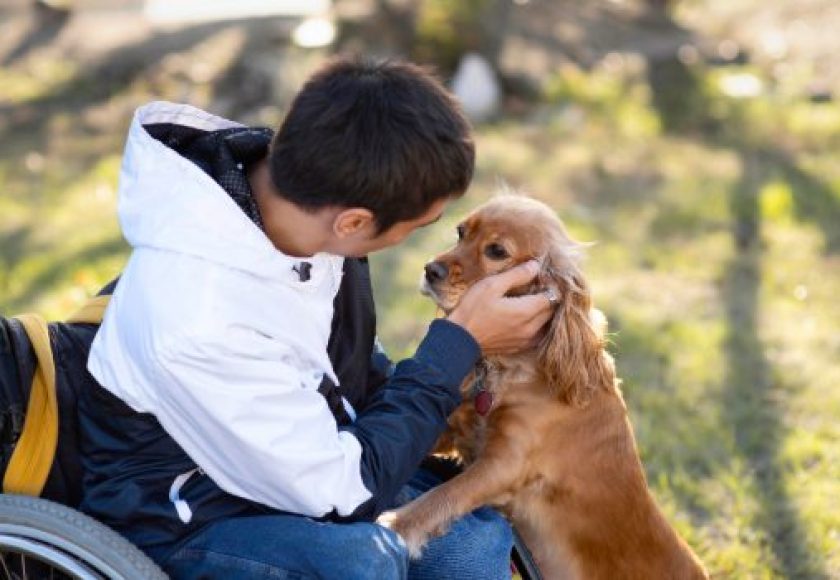Dogs are lovingly referred to as man’s best friend, and they have worked in the service of humankind for tens of thousands of years. From motivating their recipients through their companionship, assistance, and support to alerting to a potential seizure, the more than 500,000 current service dogs across the United States drastically improve lives – and in many cases, they even save lives.
Understanding the difference between the eight different types of service dogs is an important first step in appreciating their capabilities and training. Putnam Service Dogs specializes in training and providing service dogs to people who have physical disabilities (other than blindness) in an effort to improve their quality of life, including mobility assistance and facility service dogs.
The Primary Purpose of Service Dogs
While service dogs are trained to help people in a variety of ways, their overarching purpose is simple. Service dogs help people with a wide range of disabilities become active and happy participants in their own daily lives. According to the Americans with Disabilities Act (ADA), a disability is any physical or mental impairment that significantly impacts major life activities. Some well-known examples of disabilities include post-traumatic stress disorder (PTSD), cancer, epilepsy, blindness or low vision, deafness or hearing loss, major depressive disorder, ongoing mobility issues, autism, cerebral palsy, and many, many others.
Different types of service dogs are trained to take specific actions and perform tasks that relate to a disability, and in doing so, they allow an individual with that disability to participate in life more fully. In return, individuals with disabilities often feel safer, happier, and more fulfilled when paired with a service dog.
At present, Putnam Service Dogs trains Mobility Assistance and Hearing Alert Service Dogs.
Emotional Support vs. Service vs. Therapy Dogs
Aside from service dogs, individuals may also benefit from emotional support and therapy dogs. While each one can have a positive impact on their recipients’ lives, they are different in several important ways.
- Emotional support dogs provide a therapeutic benefit to their recipients primarily through their companionship. Unlike service dogs, they do not have any specialized training. They have public access rights by invitation only. It is not legally protected, as it is for service dogs.
- Therapy dogs are specially trained to offer comfort to individuals in areas like hospitals, nursing homes, or hospice care. They do not have protected access to housing or air travel, but some facilities may allow them. A 2022 study published in the journal PLOS One suggests that just 10 minutes with a therapy dog may significantly improve pain, anxiety, depression, and overall well being.
- Service dogs are rigorously trained to perform very specific actions and tasks relating to specific disabilities. They can drastically improve quality of life, and they enjoy legally-protected housing, travel, and public access. Unlike emotional support and therapy dogs, service dogs are not considered pets under the law.
It is important to note that while a service dog can provide emotional support and therapeutic benefits to their recipients, emotional support dogs and therapy dogs are not considered service dogs, and they do not have the same legal protections.
8 Types of Service Dogs
Mobility Assistance Dogs
Individuals who have impaired motor functions benefit from mobility assistance dogs in many ways depending on their recipients’ unique needs. For example, they can be trained to assist their person successfully navigate stairs or walking through crowds, carry a bag or other item, or even bring a wheelchair, walker, or cane close to individuals when needed. These amazing animals can also help people who have spinal cord injuries, arthritis, and other conditions or injuries that affect mobility.
Hearing Alert Dogs
Though people who experience deafness or hearing loss are incredible at navigating life with their other senses, hearing dogs make life safer and more fulfilling. They can alert their companions when they hear a phone ringing, a knock at the door, or a horn while walking down the sidewalk. Hearing alert dogs can wake their person when the smoke detector is going off in the middle of the night. Hearing dogs do much more than simply serve as their recipients’ ears; they give people the power to live safe independent lives.
Facility Service Dogs
Facility service dogs have been trained to work directly with a facilitator or handler to offer services in education and healthcare settings. They serve to provide a sense of calm, which can aid in recovery and boost morale. These dogs may also be trained to open doors, pick up items, or perform other tasks that help around the facility.
A courthouse facility dog is a specialized type of facility service dog that works with a handler who is a legal professional, such as a detective, forensic investigator, or victim advocate. Because these dogs are legally neutral, they can help witnesses with anxiety – especially children – feel more confident in providing testimony during court proceedings.
Psychiatric Service Dogs
Many psychiatric conditions can be quite debilitating and lead to an inability to participate in daily activities. Psychiatric service dogs primarily offer comfort and companionship during difficult times or events. For example, they may apply gentle pressure to their recipients’ lap or body during a panic attack, define their recipients’ personal space, or even sweep a room first or turn on the lights in a room to help reduce feelings of fear. This can lessen the anxiety or fear associated with many psychiatric conditions, especially post-traumatic stress disorder (PTSD), and allow recipients to live more fulfilling lives.
Diabetic Alert Dogs
Although humans have a keen sense of smell, experts estimate that dogs are somewhere between 10,000 and 100,000 more sensitive to smells. Furthermore, the part of a dog’s brain that processes and analyzes the things they smell is about 40 times larger. That means that a dog can smell changes in blood sugar levels, and when they have been properly trained as diabetic alert dogs, they can alert their recipients (or even medical professionals) to dangerous changes. This gives individuals with diabetes a sense of security and independence that can drastically improve their quality of life.
Seizure Alert and Seizure Response Dogs
Dogs have more than just an incredible sense of smell; they can also be trained to recognize oncoming seizures. Though some people may be able to pick up on warning signs that they are about to experience a seizure, many have no prior warning at all. Seizure alert and response dogs can detect seizures before their human companions. They are trained to alert their recipients or others nearby, and they can even help their companions get into a safer position until the seizure passes.
Scientists don’t understand exactly how dogs recognize seizure activity before it begins, but many believe it is an innate trait. A 2021 study published in Animals shows that even pet dogs can detect seizures via their sense of smell up to 45 minutes before they occur. However, seizure alert and response dogs are rigorously and professionally trained, so they have the tools they need to properly and consistently alert their companions while actively reducing seizure-related harm.
Autism Support Dogs
Autism support dogs offer life-changing and sometimes life-saving service to their recipients. Though their exact tasks can vary from one individual to the next, they are especially good at helping their recipients navigate through public spaces, tracking children with autism who may roam away from their caretakers, and alerting caregivers to problems or potential harm. Their ability to provide consistent companionship and calm to individuals with autism has been shown to help with communication skills, emotions, and overall quality of life.
Guide Dogs
It is believed that guide dogs were the very first formal service dogs to exist. These amazing animals assist human companions who experience blindness or vision impairment. These dogs are especially good at helping people navigate through public spaces, including busy sidewalks and stairs. One of the most fascinating and awe-inspiring traits that guide dogs display is their ability to make their own decisions when it relates to their recipients’ safety.

Training Service Dogs to Bring Happiness
These different types of service dogs are more than just well-trained pets. They drastically improve lives by monitoring their companions’ health and emotional wellbeing, giving them a sense of independence, serving as loyal companions, and even improving economic outcomes.
Putnam Service Dogs believes that every individual with disabilities deserves to be an active participant in their happy, independent, and comfortable life. We provide service dogs free to individuals who have physical disabilities other than blindness and to veterans. We seek recipients who will benefit from having a service dog, and who can competently and humanely care for one. We believe our service dogs change lives. With your help, we can continue to realize this vision.
If you want to make a difference, you can help Putnam Service Dogs by fostering or raising a puppy that will go on to become a life-changing service dog. Our professional trainers will guide and support you through each step of your journey. If you cannot foster or raise a puppy, but you still want to participate in our cause, you can help pair incredible dogs with the people who need them most through a tax-deductible donation on our website. We’re a BBB Accredited nonprofit, which less than 10% of all nonprofits qualify, and a 501(c)3.
Sources
- ADA.gov, Introduction to the Americans with Disabilities Act
- American Kennel Club, What Is a Service Dog?
- Animals, “The Untrained Response of Pet Dogs to Human Epileptic Seizures”
- PLOS One, “Outcomes of a Controlled Trial with VIsiting Therapy Dog Teams on Pain in Adults in an Emergency Department”
- The Spruce Pets, “8 Types of Service Dogs and What They Do”






